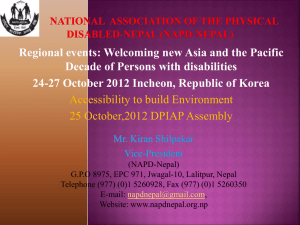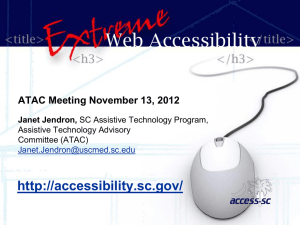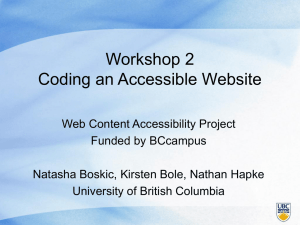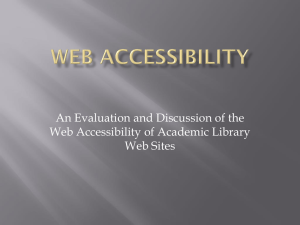Adaptable Design - Wayne State University
advertisement
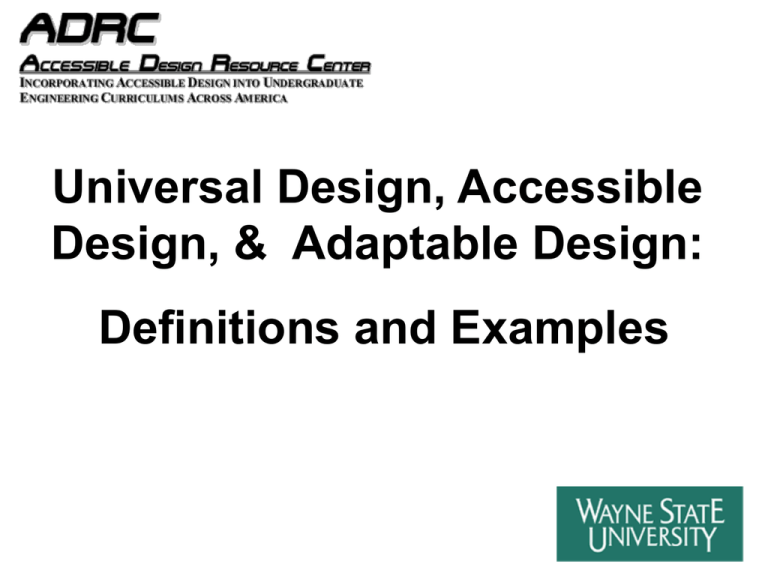
Universal Design, Accessible Design, & Adaptable Design: Definitions and Examples Goal: Define •Universal design •Accessible design •Adaptable design •Specify their relationship to the broader notion of design in general Scope of the Discussion “universal design” and "accessible design" are often used interchangeably • Both terms focus on designing products and services so that as many people, with as broad a spectrum of abilities as possible, can use them. •Yet "accessible design" and "accessibility" have taken on legal meanings that force a distinction to be drawn between universal and accessible design. • In essence, accessible design is mandated by law while universal design is not. Scope of the Discussion • Additional design categories have been proposed, in particular adaptable and transgenerational design (Story, 1998). • Of these only adaptable design will be discussed because it is closely related to accessible design. • Adaptable design is mentioned in the laws mandating accessibility of telecommunication products and services as well as electronic and information technology products and services. Scope of the Discussion The discussion will start with a definition of design and move to the narrower definitions of •Accessible design •Universal design •Adaptable design Defining Design Design can be a noun or a verb •As a noun, design refers to an object or entity •As a verb, design refers to a process For this discussion, design will be used as a verb, that is, design is a process. Defining Design "Design is the thought process comprising the creation of an entity" (Miller, 1996). More simply, the designer needs to see the connection between “problem and possibility" (Miller, 1996). Universal Design Universal Design Universal design - the design of entities that can be used and experienced by people of all abilities, to the greatest extent possible, without adaptations. Buildings, work places, products, services, and educational activities/materials can all be universally designed. Universal Design Curb cuts are the prototypical example of universal design. People in wheelchairs use curb cuts, but so do bike riders, skate boarders, and people pushing baby strollers. Accessible Design Accessible Design Accessible design - the design of entities that satisfy specific legal mandates, guidelines, or code requirements with the intent of providing accessibility to the entities for individuals with disabilities. This definition focuses on the legal implications of the term. Accessible Design Accessible design derives its legal meaning from: •Americans with Disabilities Act (ADA) •Section 255 of the Telecommunication’s Act of 1996 •Section 508 amendments to the Workforce Investment Act of 1998 Accessible Design These laws also state that either •products need to be compatible with assistive technology devices used by people with disabilities or •products are able to be modified so as to be rendered accessible Accessible Design Note: systems may be designed so that they are not accessible, but with specific modifications be made accessible to individuals with specific disabilities. Such modifications are termed accommodations and characterize the process of adaptable design. Adaptable Design Adaptable Design Adaptable design - features are modifications made to the standard design for the purpose of making the design usable for an individual, as needed. This definition focuses on modifications made to existing entities which make the entity accessible to people with disabilities. Adaptable Design •Van conversion provides wheelchair accessibility for occupants. •Vans are a standard, non- wheelchair accessible, design. After modifications, vans are wheelchair accessible. •Van accommodation is not required or mandated by any law, code or guidelines; hence, it is not considered accessible design, but adaptable design. Adaptable Design How adaptable design differs from accessible design: •adaptable design is not mandated by laws •adaptable design focuses on modifying an existing standard design Adaptable Design How adaptable design differs from universal design: •universal design creates products and services that are accessible and usable without adaptations •adaptable design focuses on modifying an existing standard design •universal design occurs at the beginning of the design process •adaptable design occurs after the design process is complete and the product has been produced Relationship Between General Design, Universal Design, and Accessible Design Relationship Between General Design, Universal Design, and Accessible Design Relationship Between General Design, Universal Design, and Accessible Design •The rectangle labeled “Entities that are accessible” is explicitly used to emphasize the fact that accessibility can be achieved by design strategies from all design categories. •If accessibility is achieved because it is mandated, then it results from accessible design strategies. •If accessibility is achieved as a result of an accommodation, it is an adaptable design strategy. •Accessibility can also result from applying universal design principles. Examples of Entities from Each Design Category Example from: Examples of Entities from Each Design Category: Universal Design Universal Design • ADJUSTABLE SEATS, STEERING WHEEL, AND FLOOR PEDALS ON CARS AND TRUCKS: The collection of adjustable features enable people with very different body sizes to use the car or truck. These adjustability features are not required or mandated by laws or regulations. • AUTOMATIC DOOR OPENERS: The automatic door openers at malls, shopping centers, and other public places are examples of universal design if they are not mandated by laws or codes. Examples from Universal & Accessible Design: Examples of Entities from Each Design Category: Accessible & Universal Design Accessible Design and Universal Design • CURB CUTS: Curb cuts were designed to allow wheelchair users to navigate and thereby have access to city streets and sidewalks, and the amenities they afford such as access to public places, buildings, shops, and restaurants. Curb cuts are mandated by ADA (Access Board, 1999) and as such an example of accessible design. However, curb cuts are used by people on roller-blades, skateboards, bicycles, tricycles, people pulling shopping carts and people pushing strollers, and therefore provide an example of universal design. Examples from Accessible Design: Examples of Entities from Each Design Category: Accessible Design Accessible Design • THE ADA ACCESSIBILITY GUIDELINES FOR BUILDINGS AND FACILITIES (ADAAG): - covers the construction and alteration of facilities in the private sector (places of public accommodation and commercial facilities) and the public sector (state and local government facilities). For example, section 4.9 deals with stairs. Section 4.9.2 deals specifically with Treads and Risers. It says that “On any given flight of stairs, all steps shall have uniform riser heights and uniform tread widths. Stair treads shall be no less than 11 in (280 mm) wide, measured from riser to riser. Open risers are not permitted.” Examples from Adaptable & Accessible Design: Examples of Entities from Each Design Category: Adaptable & Accessible Design Adaptable Design and Accessible Design • VOLUME CONTROLS FOR ATTACHING TO TELEPHONES: A volume control that attaches to a telephone is an example of an adaptable design that is also accessible design. It is a modification made to a standard design for the purpose of making it accessible to persons who are hardof-hearing (Story, 1998). This design is accessible in that the Telecommunication Act of 1996, Section 255, requires telephones that do not contain volume controls to be compatible with technologies like the attachable volume control unit so as to be accessible for individuals with hearing difficulties (Access Board, 1998). • BASE CABINETS THAT ARE REMOVABLE FROM UNDER BATHROOM SINKS (Story, 1998): Base cabinets that are removable from under bathroom sinks not only allow wheelchair users access but also allows dwarfs or short people to remove the base cabinet and use a chair. The ability to remove the base units is not mandated or required by guidelines or code as required by the definition of accessible design. Examples from Adaptable, Accessible & Universal Design: Examples of Entities from Each Design Category: Adaptable, Accessible, & Universal Design Adaptable, Accessible, and Universal Design • RAMPS TO AN EXISTING PUBLIC BUILDING WHEN RENOVATED: When an existing public building undergoes major renovation it may come under ADA accessibility requirements. One such adaptation is the addition of a wheelchair ramp. Ramps not only improve accessibility for people in wheelchairs, they also improve accessibility for people pushing strollers, or pulling suitcases, or people with walkers. The ramps are like curb-cuts in that they improve accessibility for all users and hence exemplify universal design. Ramps provided under the conditions described above are accessible designs because they are mandated. They are adaptable designs because they are added to a standard design. Examples from Adaptable Design: Examples of Entities from Each Design Category: Adaptable Design Adaptable Design • DAMPERS FOR VIBRATION REDUCTION ON TENNIS RACQUETS: One may purchase a variety of devices that fit around the strings of a tennis racquet near the frame. These devices change the vibration patterns of the racquet. If the undamped racquet produces a vibration pattern that cause undue stress on a player's elbow it can result in tennis elbow, which is a painful condition. The string damping device changes the racquet’s vibration pattern so that it no longer places undue stress on the player's elbow and thereby avoids injury. The device is an adaptation in that it is a modification to a standard product that makes the racquet usable to an individual. For any given racquet, the adaptation only works for people with certain arm characteristics and not others; hence, it is not universal design. The device is not mandated nor does it provide accessibility to individuals with disabilities; hence, it is not accessible design. • VAN CONVERSIONS FOR WHEELCHAIR ACCESSIBILITY: There is an active aftermarket business centered on modifying vans to be wheelchair accessible for both drives and passengers. Two examples of companies providing van conversions are Kino Mobility, Inc. and New England Wheels, Inc. (Inc., 2002; New England Wheels, 2003). This is adaptable design because a standard product is being modified so as to be accessible to individuals using a wheelchair. This is not an example of an entity in the intersection of adaptable and accessible design because the van conversions are not mandated by any law, regulations, or code. Conclusions Conclusions Design is the thought process comprising the creation of an entity. •When conceptualizing the “problem and possibilities” from a UNIVERSAL DESIGN perspective, THE POSSIBILITIES INCLUDE AN ENTITY THAT CAN BE USED AND EXPERIENCED BY PEOPLE OF ALL ABILITIES, TO THE GREATEST EXTENT POSSIBLE WITHOUT ADAPTATIONS. • When approaching the same problem from an ACCESSIBLE DESIGN perspective, THE POSSIBILITIES WILL FOCUS ON HOW TO SATISFY LEGAL MANDATES, GUIDELINES, OR CODES TO ENSURE ACCESSIBILITY. • From an ADAPTABLE DESIGN perspective, THE POSSIBILITIES INVOLVE MODIFYING OR ACCOMMODATING A STANDARD DESIGN FOR THE PURPOSE OF MAKING IT USABLE FOR AN INDIVIDUAL WITH A DISABILITY. Conclusions Forces Driving Universal, Accessible, & Adaptable Design •highly competitive global markets •evolving accessibility legislation •require corporations to maximize their products’ market potential and services while addressing the needs of individuals with disabilities Conclusions Forces Driving Universal, Accessible, & Adaptable Design • these dual forces require that designers understand and utilize different design perspectives •during the design thought process, designers should include a deliberate discussion and analysis of which design approach will be used to address the specified problem Conclusions Forces Driving Universal, Accessible, & Adaptable Design •forgoing such deliberations could be very costly to a corporation in terms of •lost market share •possible litigation for failing to comply with mandated accessibility requirements



